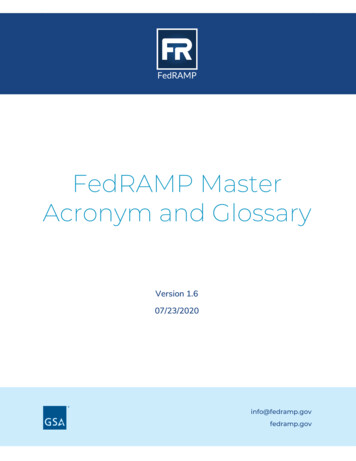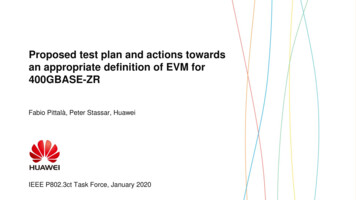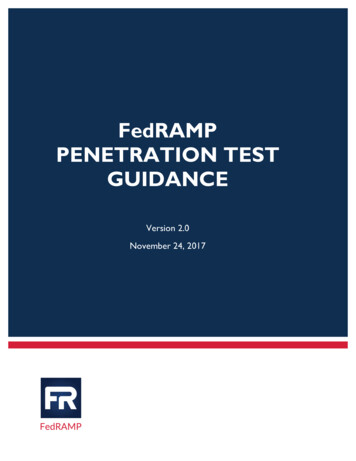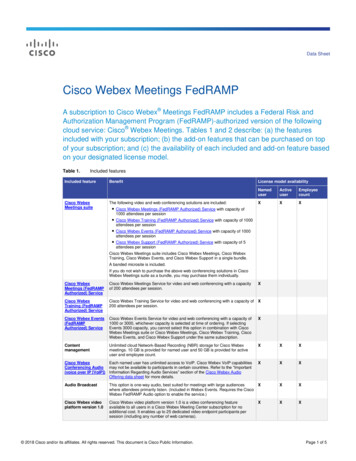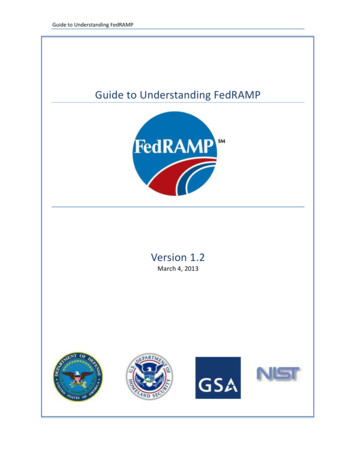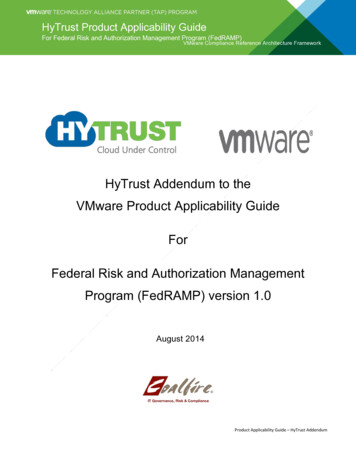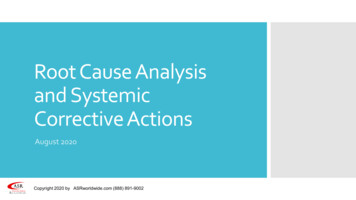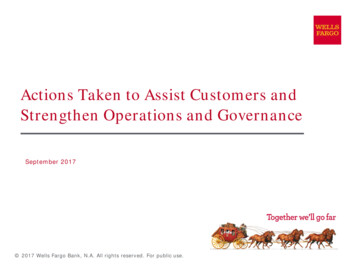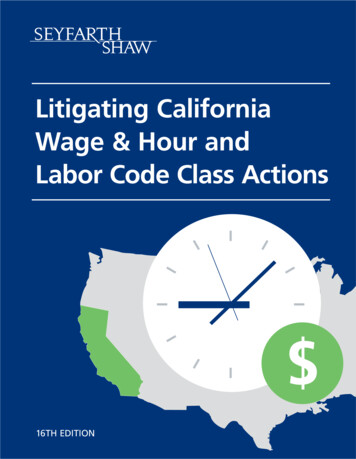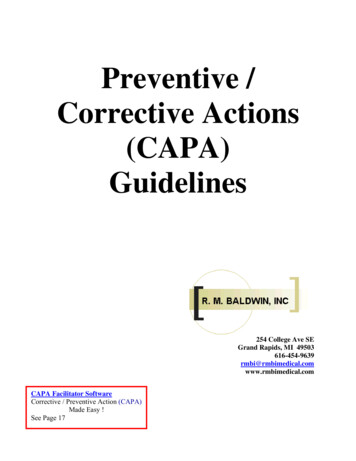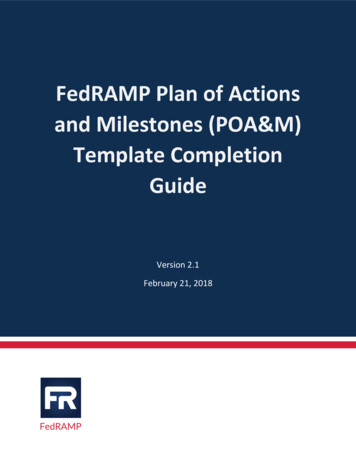
Transcription
FedRAMP Plan of Actionsand Milestones (POA&M)Template CompletionGuideVersion 2.1February 21, 2018
DOCUMENT REVISION 151.0AllPublish DateFedRAMP PMO09/01/20151.1AllClarifications and format updatesFedRAMP PMOFedRAMP PMO10/21/20161.24-5Instructions for the new Integrated InventoryTemplate Section 2.3; Operational Requirements –False Positive Updates to Table 2 – POA&M ItemsColumn Information Description and Section 2.36/6/20171.2TitleUpdated LogoFedRAMP PMO1/31/20182.0AllGeneral changes to grammar and use of terminologyto add clarity, as well as consistency with otherFedRAMP documents.FedRAMP PMO3Corrected conflicting information in Sections 2 and2.3 of the POA&M Template Completion Guideregarding the FedRAMP Integrated InventoryWorkbook Template.FedRAMP PMOFedRAMP PMO1/31/20182.01/31/20182.06Added text instructing CSPs to deliver the inventoryworkbook template as part of their monthlyConMon package, along with or included in theirPOA&M, in the same location as their POA&M.1/31/20182.07Updated guidance that findings from automatedtools only need to be added to the POA&M oncethey are late.FedRAMP PMO1/31/20182.07Automated tool findings identified as Low will beconsidered late after 180 calendar days.FedRAMP PMO2/21/20182.13Revised guidance in the description for Column A –POA&M IDFedRAMP PMO2/21/20182.15Added a description for Column AA – Auto-ApproveFedRAMP PMO2/21/20182.16, 8Updated links to resources resulting from newFedRAMP web site migration.FedRAMP PMO4/3/20182.17Updated footnote.FedRAMP PMO i
ABOUT THIS DOCUMENTThis document provides guidance on completing the Federal Risk and Authorization ManagementProgram (FedRAMP) Plan of Action and Milestones (POA&M) Template in support of achieving andmaintaining a security authorization that meets FedRAMP requirements.This document is not a FedRAMP template – there is nothing to fill out in this document.This document uses the term authorizing official (AO). For systems with a Joint Authorization Board(JAB) provisional authorization to operate (P-ATO), AO refers primarily to the JAB unless this documentexplicitly says Agency AO. For systems with a FedRAMP Agency authorization to operate (ATO), AOrefers to each leveraging Agency’s AO.The term authorization refers to either a FedRAMP JAB P-ATO or a FedRAMP Agency ATO.The term third-party assessment organization (3PAO) refers to an accredited 3PAO. Use of an accredited3PAO is required for systems with a FedRAMP JAB P-ATO; however, for systems with a FedRAMP AgencyATO this may refer to any assessment organization designated by the Agency AO.WHO SHOULD USE THIS DOCUMENT?This document is intended to be used by Cloud Service Providers (CSPs), 3PAOs, government contractorsworking on FedRAMP projects, and government employees working on FedRAMP projects.HOW TO CONTACT USQuestions about FedRAMP or this document should be directed to info@fedramp.gov.For more information about FedRAMP, visit the website at http://www.fedramp.gov. ii
TABLE OF CONTENTSDOCUMENT REVISION HISTORY . IABOUT THIS DOCUMENT . IIWHO SHOULD USE THIS DOCUMENT? . IIHOW TO CONTACT US. II1.INTRODUCTION . 11.1.POA&M Purpose . 11.2.Scope . 22.POA&M TEMPLATE . 22.1.Worksheet 1: Open POA&M Items. 22.2.Worksheet 2: Closed POA&M Items . 62.3.Integrated Inventory Workbook . 63.GENERAL REQUIREMENTS . 7APPENDIX A:FEDRAMP ACRONYMS . 8LIST OF TABLESTable 1. POA&M Items Header Information Description . 2Table 2. POA&M Items Column Information Description. 3 iii
1.INTRODUCTIONThis document provides guidance for completing and maintaining a FedRAMP-compliant POA&M usingthe FedRAMP POA&M Template. The POA&M is a key document in the security authorization packageand monthly continuous monitoring activities. It identifies the system’s known weaknesses and securitydeficiencies, and describes the specific activities the CSP will take to correct them.A CSP applying for a FedRAMP JAB P-ATO, or a FedRAMP Agency ATO, must establish and maintain aPOA&M for their system in accordance with this POA&M Template Completion Guide using theFedRAMP POA&M Template. The FedRAMP POA&M Template is available separately at:http://www.fedramp.gov/.The FedRAMP POA&M Template provides the required information presentation format for preparingand maintaining a POA&M for the system. The CSP may add to the format, as necessary, to comply withits internal policies and FedRAMP requirements; however, CSPs are not permitted to alter or deleteexisting columns or headers.1.1.POA&M PURPOSEThe purpose of the POA&M is to facilitate a disciplined and structured approach to tracking riskmitigation activities in accordance with the CSP’s priorities. The POA&M includes security findings forthe system from periodic security assessments and ongoing continuous monitoring activities. ThePOA&M includes the CSP’s intended corrective actions and current disposition for those findings.FedRAMP uses the POA&M to monitor the CSP’s progress in correcting these findings.The POA&M includes the:§Security categorization of the cloud information system;§Specific weaknesses or deficiencies in deployed security controls;§Importance of the identified security control weaknesses or deficiencies;§Scope of the weakness in components within the environment; and§Proposed risk mitigation approach to address the identified weaknesses or deficiencies in thesecurity control implementations (e.g., prioritization of risk mitigation actions and allocation ofrisk mitigation resources).The POA&M identifies: (i) the tasks the CSP plans to accomplish, including a recommendation forcompletion either before or after information system implementation; (ii) any milestones the CSP hasset in place for meeting the tasks; and (iii) the scheduled completion dates the CSP has set for eachmilestone. 1
1.2.SCOPEThe scope of the POA&M includes security control implementations, including all management,operational, and technical implementations, that have unacceptable weaknesses or deficiencies. TheCSP is required to submit an updated POA&M to the AO in accordance with the FedRAMP ContinuousMonitoring Strategy & Guide.2.POA&M TEMPLATEThe FedRAMP POA&M Template is an Excel Workbook containing two worksheets: Open POA&M Items, which contains the unresolved entries; and Closed POA&M Items, which contains resolved entries.2.1.WORKSHEET 1: OPEN POA&M ITEMSThe Open POA&M Items worksheet has two sections. The top section of the worksheet contains basicinformation about the system, which is described in Table 1. POA&M Items Header InformationDescription, below. The bottom section is a list that enumerates each open POA&M entry, which isdescribed in Table 2. POA&M Items Column Information Description, below.Table 1. POA&M Items Header Information DescriptionFEDRAMP SYSTEMCATEGORIZATIONIDENTITY ASSURANCE LEVEL (IAL)CSPThe Vendor Name as supplied in the documents provided to the AO.System NameThe Information System Name as supplied in the documents provided to the AO.Impact LevelCloud Service Offerings (CSOs) are categorized as Low, Moderate, or High based ona completed FIPS 199/800-60 evaluation. FedRAMP supports CSOs with High,Moderate, and Low security impact levels.POA&M DateThe date the POA&M was last updated. For an initial authorization, this is the dateto which the CSP committed in their continuous monitoring plan. 2
The bottom section of the Open POA&M Items worksheet includes the CSP’s corrective action plan usedto track IT security weaknesses. This section of the POA&M worksheet has similarities to the NationalInstitute of Standards and Technology’s (NIST) format requirements; however, it contains additionaldata and formatting as required by FedRAMP.Table 2. POA&M Items Column Information DescriptionCOLUMNColumn A – POA&M IDDETAILSAssign a unique identifier to each POA&M item. While this can be in any format ornaming convention that produces uniqueness, FedRAMP recommends the conventionV- incremented number (e.g., V-123). This identifier is assigned by the CSP to aunique vulnerability in the CSP system.Often, during annual assessment activities the 3PAO identifies a vulnerability that theCSP has already identified through continuous monitoring activities, or vice versa. If thesame vulnerability is detected on the same assets, the same POA&M ID must be usedby both parties. The earlier of the two detection dates applies. If the same vulnerabilityis discovered on additional assets at a later date, a new POA&M ID and detection datemay be used for the new assets.Column B – ControlsSpecify the FedRAMP security control affected by the weakness identified during thesecurity assessment process.Column C – WeaknessNameSpecify a name for the identified weakness that provides a general idea of theweakness. Use the Weakness Name provided by the security assessor, or taken fromthe vulnerability scanner that discovered the weakness.Column D – WeaknessDescriptionDescribe the weakness identified during the assessment process. Use the WeaknessDescription provided by the security assessor or the vulnerability scanner thatdiscovered the weakness. Provide sufficient data to facilitate oversight and tracking.This description must demonstrate awareness of the weakness and facilitate thecreation of specific milestones to address the weakness. In cases where it is necessaryto provide sensitive information to describe the weakness, italicize the sensitiveinformation to identify it and include a note in the description stating that it issensitive.Column E – WeaknessDetector SourceSpecify the name of the 3PAO, vulnerability scanner, or other entity that first identifiedthe weakness. In cases where there are multiple 3PAOs, include each one on a newline.Column F – WeaknessSource IdentifierOften, the scanner/assessor will provide an identifier (ID/Reference #) that specifies theweakness in question. This allows further research of the weakness. Provide theidentifier, or state that no identifier exists.Column G – AssetIdentifierList the asset/platform on which the weakness was found. This must correspond to theAsset Identifier for the item provided in the system’s Integrated Inventory Workbook.The inventory workbook must be maintained as part of the CSP’s configurationmanagement processes, and submitted as one of continuous monitoring deliverableseach month. Include a complete Asset Identifier for each affected asset. Do not use anabbreviation or “shorthand.” The CSP may obfuscate the asset information when it is 3
COLUMNDETAILSrequired by the internal policies of the CSP. The Asset Identifier must be unique andconsistent across all POA&M documents, 3PAOs, and any vulnerability scanning tools.Column H – Point ofContactIdentify the person/role that the AO holds responsible for resolving the weakness. TheCSP must identify and document a Point of Contact (POC) for each reported weakness.Column I – ResourcesRequiredIdentify resources required for resolving the weakness and when applicable, provide anestimated staff time in hours.Column J – OverallRemediation PlanProvide a high-level summary of the actions required to remediate the plan. In caseswhere it is necessary to provide sensitive information to describe the remediation plan,italicize the sensitive information to identify it and include a note in the descriptionstating that it is sensitive.Column K – OriginalDetection DateProvide the month, day, and year when the weakness was first detected. This must beconsistent with the Security Assessment Report (SAR) and/or any continuousmonitoring activities. The CSP may not change the Original Detection Date.Column L – ScheduledCompletion DateThe CSP must assign a completion date to every weakness that includes the month,day, and year. The Scheduled Completion Date column must not change once it isrecorded. See Section 2.2 for guidance on closing a POA&M item.Column M – PlannedMilestonesEach weakness must have a milestone entered with it that identifies specific actions tocorrect the weakness with an associated completion date. Planned Milestone entriesshall not change once they are recorded.Column N – MilestoneChangesList any changes to existing milestones in Column M, Planned Milestones, in thiscolumn.Column O – Status DateThis column must provide the latest date an action was taken to remediate theweakness or some change was made to the POA&M item.Column P – VendorDependencyThis column indicates the remediation of the weakness required by the action of a thirdparty vendor (e.g., through the issuing of a patch that is not yet released). The CSP isrequired to check the status of the vendor’s remedy at least every 30 days.As long as the fix is still pending from the vendor, and the CSP has checked-in within 30days of POA&M submission, FedRAMP will not count the entry as late.Once the vendor makes the fix available, the CSP has 30 days to remediate highvulnerabilities, 90 days to remediate moderate vulnerabilities, and 180 days toremediate low vulnerabilities from the date the vendor makes the fix available. The CSPmust provide the vendor’s release date in column Z (comments). In this case, the CSPmay overwrite the auto-calculated scheduled completion date found in column L.Column Q – Last VendorCheck-in DateThis column is used to record the date the CSP most recently checked-in with a thirdparty vendor regarding the availability of an un-released remedy for a known productvulnerability. If Column P – Vendor Dependency is “Yes,” the CSP must check-in with thethird-party vendor at least every 30 days and record the most recent date of check-inhere. If Column P – Vendor Dependency is “No,” the CSP may leave this column blank. 4
COLUMNDETAILSColumn R – VendorDependent ProductNameIf Column P – Vendor Dependency is “Yes,” the CSP must provide the name of theproduct that the third-party vendor has responsibility. If Column P – VendorDependency is “No,” the CSP may leave this column blank.Column S – Original RiskRatingProvide the original risk rating of the weakness at the time it was identified as part ofan assessment and/or continuous monitoring activities.Column T – AdjustedRisk RatingProvide the adjusted risk rating after a FedRAMP Deviation Request Form is submitted.If no risk adjustment is made, state N/A. In the case that the scanner changes its riskrating from a lower to a higher risk rating, the CSP may update this column and setcolumn U to “Yes.” No deviation request form is necessary in this case.Column U – RiskAdjustmentState the status of the deviation request for a risk adjustment request. If the CSPbelieves a risk adjustment is appropriate, they must set this column to “Pending” andimmediately submit a deviation request to their AO using the FedRAMP DeviationRequest Form, including mitigating factors. If the AO approves the deviation request,the CSP must change this to “Yes.” If the AO denies the deviation request, or if the CSPdoes not intend to request a risk adjustment, the CSP must set this entry to “No.”The CSP must set this column to “pending” if submitting a risk adjustment. Theadjustment is finalized (setting the Risk Adjustment to “yes”) if it is approved by the AO.Only AO-approved risk adjustments may alter the scheduled completion date.Column V – FalsePositiveState the status of the deviation request for a false positive (FP). A FP occurs when avulnerability is identified that does not actually exist on the system. This is known tohappen from time-to-time with scanning tools. If the CSP believes a finding is an FP,they must set this column to “Pending” and immediately submit a deviation request totheir AO using the FedRAMP Deviation Request Form, including evidence of the FP. Ifthe AO approves the deviation request, the CSP must change this to “Yes.” If the AOdenies the deviation request, or if the CSP does not believe the finding is a FP, the CSPmust set this entry to “No.”AO-approved false positives can also be closed; see Section 2.2 for guidance on closinga POA&M item.Column W – OperationalRequirementState the status of the deviation request for an operational requirement (OR). An ORmeans that there is a weakness in the system that will remain an open vulnerabilitythat cannot be corrected without impacting the full operation of the system. An OR isalso an open vulnerability that could be exploited, regardless of the limited opportunityfor exploitation, such as a component that is installed but not enabled. A CSPdetermination of an operational requirement will cause this column to be set to“pending.” The deviation is finalized, setting the status to “yes”, if it is approved by theAO.Approved operational requirements must remain on the Open POA&M Itemsworksheet, and must be periodically reassessed by the CSP. 5
COLUMNDETAILSColumn X – DeviationRationaleProvide a rationale for any deviation request submitted to the AO. For operationalrequirements and risk adjustments, include mitigating factors and compensatingcontrols that address the specific risk to the system. For false positives, includeinformation about evidence/artifacts that support the result.Column Y – SupportingDocumentsList any additional documents that are associated with the POA&M item.Column Z – CommentsProvide any additional comments that have not been provided in any of the othercolumns.Column AA –Auto-ApproveIndicates an automatic risk adjustment. This field is only for use by CSPs with prior JABapproval to automatically downgrade risks based on established criteria.2.2.WORKSHEET 2: CLOSED POA&M ITEMSThe top of the Closed POA&M Items worksheet contains the system information as the top of the OpenPOA&M Items worksheet. The remainder of the worksheet contains the POA&M items that arecompleted. The details should reflect almost all of the information provided in the Open POA&M Itemsworksheet; however, the CSP must update Column O – Status Date, with the date of completion.To “close” a POA&M item, update the date in Column O – Status Date, and move the POA&M item toWorksheet 2, Closed POA&M Items.A POA&M item can be moved to the Closed POA&M Items worksheet when either of the followingoccurs:§All corrective actions have been applied and evidence of mitigation is collected by the CSPavailable for inspection. Evidence of mitigation must then be verified by a 3PAO during initialand periodic assessments, and may be requested by the AO at any time.§A false positive deviation request was approved by the AO.2.3.INTEGRATED IN
The scope of the POA&M includes security control implementations, including all management, operational, and technical implementations, that have unacceptable weaknesses or deficiencies. The CSP is required to submit an updated POA&M to the AO in accordance with the FedRAMP Continuo
